Saitama Rapid Railway 2000 series
The Saitama Railway 2000 series (埼玉高速鉄道2000系) is an electric multiple unit (EMU) train type operated on the Saitama Rapid Railway Line in Saitama Prefecture, Japan, by the third-sector railway operating company Saitama Railway Corporation since March 2001.
| Saitama Rapid Railway 2000 series | |
|---|---|
 2103-2803 on the Tokyu Meguro Line, September 2005 | |
| In service | 2001–present |
| Manufacturer | Kawasaki and Kinki Sharyo |
| Constructed | 2001-2002 |
| Entered service | 28 March 2001 |
| Number built | 60 cars (10 sets) |
| Number in service | 60 cars (10 sets) |
| Formation | 6 cars per trainset |
| Fleet numbers | 2001–2010 |
| Operator(s) | Saitama Railway Corporation |
| Depot(s) | Urawa-Misono |
| Line(s) served | Saitama Rapid Railway Line, Tokyo Metro Namboku Line, Tokyu Meguro Line, Tokyu Shin-Yokohama Line |
| Specifications | |
| Car body construction | Aluminium alloy |
| Car length | 20.66 m (67 ft 9 in) (end cars) 20 m (65 ft 7 in) (intermediate cars) |
| Width | 2.78 m (9 ft 1 in) |
| Height | 4.04 m (13 ft 3 in) |
| Doors | 4 pairs per side |
| Maximum speed | 110 km/h (70 mph) |
| Weight | 167.2 t (164.6 long tons; 184.3 short tons) |
| Traction system | Mitsubishi Electric MAP-194-15V90 2-level IGBT–VVVF inverter vector control |
| Traction motors | 12 × 190 kW (250 hp) 3-phase AC induction motor |
| Power output | 2.28 MW (3,060 hp) |
| Acceleration | 0.92 m/s2 (3.0 ft/s2) |
| Deceleration | 0.97 m/s2 (3.2 ft/s2) (service) 1.3 m/s2 (4.3 ft/s2) (emergency) |
| Electric system(s) | 1,500 V DC overhead catenary |
| Current collector(s) | Pantograph |
| Track gauge | 1,067 mm (3 ft 6 in) |
Operations
The trains are used on Saitama Rapid Railway Line services, with through-running to and from the Tokyo Metro Namboku Line, Tokyu Meguro Line, and the Tokyu Shin-Yokohama Line.[1]
Formations
As of 1 April 2014, the fleet consists of 10 six-car sets, each formed of three motored ("M") cars and three non-powered trailer ("T") cars, as shown below, with car 1 at the northern (Urawa-Misono) end.[1]
| Car No. | 1 | 2 | 3 | 4 | 5 | 6 |
|---|---|---|---|---|---|---|
| Designation | CT1 | M1-1 | Tc2 | M1-3 | M1-4 | CT2 |
| Numbering | 2100 | 2200 | 2500 | 2600 | 2700 | 2800 |
- Car 2 has a lozenge-type pantograph, and car 4 has two.[1]
- Cars 2 and 5 each have a wheelchair space.[1]
- Car 4 is designated as a mildy air-conditioned car.[1]
Interior
Passenger accommodation consists of longitudinal bench seating with priority seats in each car.[1]
 Interior view
Interior view Priority seating (right) at end of car
Priority seating (right) at end of car
History
The 2000 series trains entered service on 28 March 2001, coinciding with the opening of the Saitama Rapid Railway Line.[1]
References
- 私鉄車両編成表 2014 [Private Railway Rolling Stock Formations - 2014]. Japan: Kotsu Shimbunsha. 24 July 2014. p. 23. ISBN 978-4-330-48414-3.